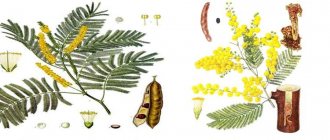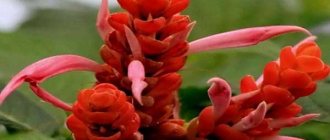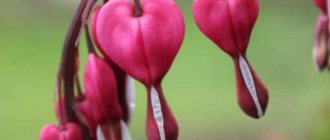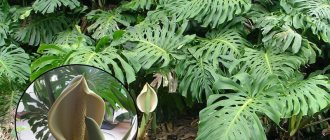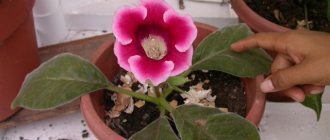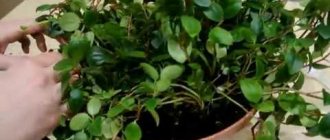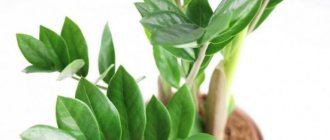Description
Arrowroot is an ornamental herbaceous perennial from the Marantaceae family. It is named after the medieval physician and botanist Bartolomeo Maranta. Sizes and appearance vary greatly depending on the variety. At home you can rarely find arrowroot taller than 30 cm, however, in natural conditions the height of the bush can reach one and a half meters. The leaves are large, patterned, and oval in shape. A young specimen has erect stems, but with age they lean more and more toward the ground.
This is interesting! With the onset of darkness, arrowroot raises its leaves to the sky, exposing their back side. This is very reminiscent of a believer folding his hands in prayer. This is where the plant got its second name - “Prayer Plant”. Arrowroot also has a third name, and, oddly enough, it is also associated with religion. The shape of the leaves resembles the tablets of Moses, and each leaf has 10 spots, just like the number of commandments on the tablets. That’s why some people call arrowroot the “10 Commandments.”
The root system of arrowroot is represented by tubers. The tubers of some arrowroot species are edible and are cultivated in several countries. Starch is also extracted from them for use in medicine.
Arrowroot propagation
The flower is propagated by vegetative division of its different parts. The seed method of propagating arrowroot at home is not practiced, and there is no shortage of ready-made plants in flower shops. You can get new copies from it in the following ways.
Cuttings
It is advisable that at least 2 buds (about 8 cm long) be preserved on the cuttings. To root, just place them in a glass of water; you can use light soil, such as sandy soil. It should always be moderately moist and warm. You can expect the first roots to appear in the right conditions after 1-1.5 months, after which the seedlings can be transplanted into a container with soil prepared for an adult plant.
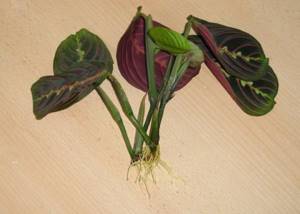
Dividing the bush
To propagate arrowroot by division, you need an adult bush with a well-grown root system. Division is combined with spring replanting. Damaged surfaces are sprinkled with charcoal. Each division is planted separately and for the first time covered with a plastic bag to create warm, humid conditions, close to tropical ones, so that rooting is quick and easy.
Leaf
Even a single leaf of a plant can take root and give birth to new specimens. To do this, it is either dropped into the substrate and covered with film, or placed on its surface and pressed tightly with glass. You can make light cuts where the veins diverge on the underside of the leaf. As soon as shoots begin to emerge at the rooting site, the cover must be removed. You can transplant to a new place after the leaf has completely withered and new shoots have formed several leaves.
Varieties of arrowroot
Several dozen different types of indoor plants are grown at home. The most popular types of arrowroot with photos:
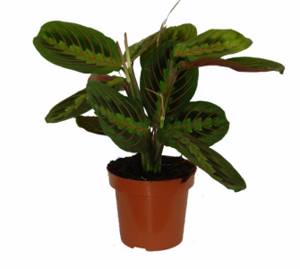
Two-color arrowroot
The main difference between this flower is the absence of tubers. The leaf has an oval shape and is dark and light green in color. The edge of a bicolor arrowroot leaf is usually wavy.
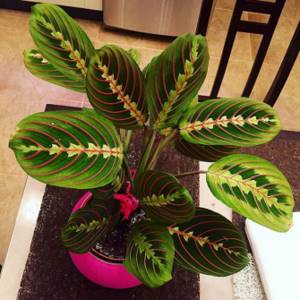
Tricolor arrowroot
It is distinguished by red veins on the leaf blade. The color of the leaves also contains green and yellow. The reverse side of the sheet is painted crimson.

Reed arrowroot
This plant has slightly elongated leaves. They are also painted in dark and light green, while the light spots on the sheet may be located asymmetrically.
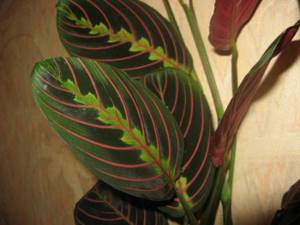
Features of watering
Many people want to bring arrowroot into their home. Caring for this flower at home involves creating ideal conditions for growth. Of course, you should also know the features of watering. After all, this plant needs to be watered not according to a schedule, but according to the condition of the soil. The soil should be slightly dry.
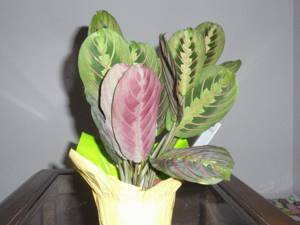
Be sure to use softened water at room temperature to water the plant. This can be melted water, boiled water, or water that has been left standing for 24 hours at room temperature.
Remember that in summer the soil dries out much faster, so the frequency of watering must be increased.
- The arrowroot plant needs moderate watering. You should pay attention to the flower development cycle. During the active growth stage, it is necessary to increase the amount of watering, but do not overdo it. Ideally, the soil should be constantly moist at this time. The dormant period requires less watering.
- In winter, the plant can be watered 2 times a week. In addition, you can alternate watering and spraying. Remember that arrowroot is a plant that loves spraying, regardless of the time of year.
Humidified air is ideal conditions for the growth of arrowroot. Caring for this plant involves constantly moistening the environment, up to 90%. To do this, it is advisable to frequently spray the plant with warm, settled, soft water (20 °C). In summer, the plant can be placed in trays with moss or stones so that the water does not touch the bottom of the container. Otherwise, the root system of the plant will be waterlogged, which can lead to its rotting.
Types of arrowroot - varieties with photos
There are a huge variety of arrowroot varieties, but several of them are usually grown at home and on the farm. These are mainly decorative varieties. Breeders are constantly developing new and interesting colors. Most of them can be classified into two categories: bicolor and tricolor, according to the number of colors in which the leaf plate is painted.
White veined arrowroot
The compact perennial bush gradually grows to a semi-ampeloid form. This category includes a number of varieties and subspecies with different leaf colors.
But the general outlines remain unchanged: oblong, medullary or wide leaves, approximately 7x10 to 10x15 cm. They grow at an acute angle relative to the petiole. The rhizome of the bush is developed, with oval tubers resembling potatoes. White veins appear on the leaf blade, which is why the variety got its name. The reverse side of the leaf is usually reddish.
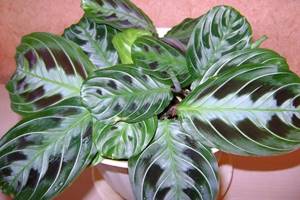
Red veined arrowroot or Fascinator
This is a bright representative of tricolors. The main background of the leaf blade is dark green, sometimes brownish. The leaves become lighter towards the edges. A light stripe runs through the center, from which pronounced transverse veins diverge. They are colored red, the saturation of which varies from very pale to deep purple. Another feature is the broken direction of the stems.
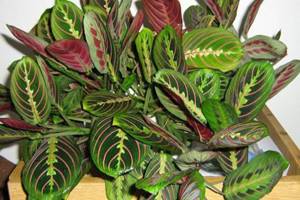
Comb arrowroot
A medium-sized bush reaches approximately 40 cm. The succulent creeping rhizome is short, with fusiform thickenings for the accumulation of nutrients and moisture. The leaves are wide or oblong, up to 15 cm. The edges of the plate are slightly wavy.
The peculiarity of the comb arrowroot is its color. A continuous light green ridge appears on the green leaf, from which broad dark strokes radiate. They form a continuous border, and the ridge gradually becomes sharper.
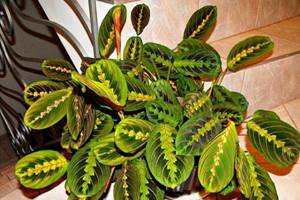
Reed arrowroot
One of the most interesting and unusual species stands out against the general background. The height of the erect stems sometimes exceeds 120 cm. The leaves are elongated, egg-shaped. They become sharper towards the ends. The edge is painted in a dark bluish tint. The rhizome is densely strewn with tubers.
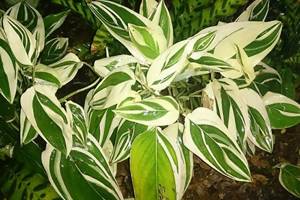
Maranta Kerkhoven
This is the most common and famous variety. The central vein appears on the dark sheet plate. On both sides of it there are symmetrical strokes, which darken and brown as they grow. At the same time, they remain separate and do not merge into one stripe. There are longitudinal veins, although they are practically invisible.
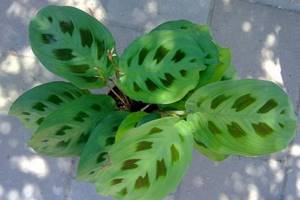
Maranta Maricella
The background of the leaf blade of this variety is dark green. This makes it stand out from the rest. But the veins and stripes are of a light light green color. This coloring is reminiscent of a classic negative.

Maranta Massanja
This is an exquisite variety, which is also called black arrowroot. Outwardly, it is not far from the classic white-veined one. The difference is that the underlying green background is retained around the edge. From the main vein, diverging longitudinal ones protrude sharply, maximally light or even white. Contrast is provided by dark strokes between them.
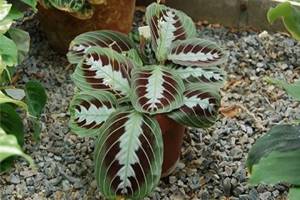
Maranta Emeral Beauty
It differs from the previous type in the width of the light stripe. It occupies up to half the sheet, and the color transition is gradual, without pronounced boundaries or spots.

Maranta Beauty Kim
This is one of the most variegated varieties with dark green or brownish spots, light green strokes, streaks and white stripes that can occupy up to half the leaf.
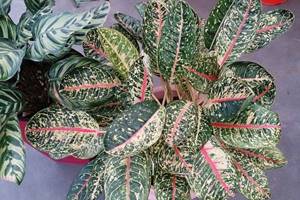
"Massange" (Maranta leuconeura Massangeana)
This variety can be classified as black arrowroot because they have a dark color in the middle of the leaf. The pattern on the leaves has a contrasting shade, the edges of the leaves are green, and there are light green stripes of lateral veins on the sides. The flower itself is miniature, 16 centimeters high.
You need to care for this variety carefully, as the variety is quite capricious.
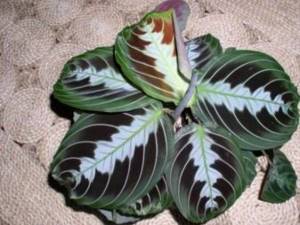
"Marisella" (M. leuconeura Marisela)
The main background is dark green. Where the central vein is located, a jagged pattern is visible, and the side veins are practically invisible.

"Kerchoveana" (M. leuconeura Kerchoveana)
This is a tall and spreading variety. The leaves of the plant have an elongated shape and their length is 13-16 centimeters. The leaf blade has very bright colors. The background is bright green, with dark brown strokes and eyes. The leaves have spots that do not merge into a continuous mass. The bottom of the sheet is painted in blue and red tones. This variety has a height of 26 centimeters. The flowers are small in size, dim and collected in 2-3 pieces, have a pale lilac hue. The veins on the leaves have a non-relief shape and do not stand out in color at all.
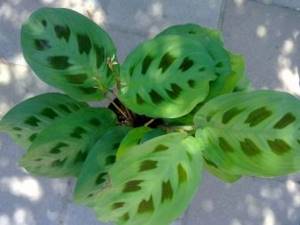
"Beauty Kim" (leuconeura Beauty Kim)
The leaves are smooth, heart-shaped or oval-shaped, with sharp edges. The main background is light green with dark greenish spotted patterns. On the surface of the leaf there are strokes, stripes that have light green, pale yellow or white shades. A few leaves may only be half white. The patterns are located along the main and lateral veins of the leaf, but the veins themselves are dim.
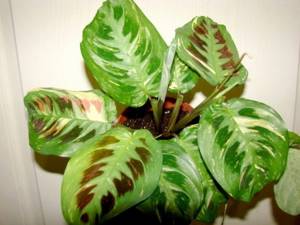
"Emerald Beauty" (leuconeura Emerald Beauty)
This variety is similar in color to the previous one. It has variegated shades, but the pattern is blurry, the background itself is not contrasting, and there are no dark green spots. The leaves are shiny.
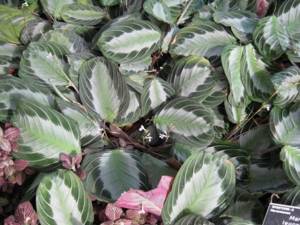
In addition to these varieties, there are more than 21 varieties. The varieties that were given in the article are distinguished by the bright color of their leaves. The remaining varieties could not take root in artificial conditions.
Types and varieties of arrowroot
Each specimen of arrowroot will grow unique, because its color is affected by watering, lighting and other care features. But the main role in the appearance of the flower is still played by varietal characteristics. In total there are about 25 types of arrowroot and several hundred varieties. Let's consider those that are popular in indoor floriculture.
White veined (Leuconeura)

The species got its name due to the distinctly protruding white veins on the leaves. The reverse side of the sheet is most often red or burgundy. It has a short stem - no more than 15 cm, wide oval leaves (10-15 cm in length and 5-7 cm in width). This species includes a number of different varieties that differ from each other in shape and color.
Massangeana or Black

A miniature variety that does not grow more than 15 cm. It is the most capricious to care for and is not recommended for beginning gardeners. Arrowroot Massanja is popularly called “Black” because of the very dark color of the center of the leaf blade. The edges of the leaves are green, and in the center there is a white stripe along the central vein. The color of the veins varies from light green to white.
Bicolor
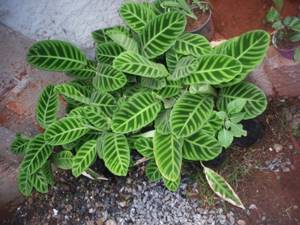
Arrowroot Bicolor has oval leaves with wavy edges. The leaf plates are painted in 2 colors - light and dark green. A feature of this species is the absence of tubers. Bicolor arrowroot is rarely grown at home.
Reed (Arundinacea)

The largest type of arrowroot. It has erect stems up to 130-150 cm high. Each stem has 1 ovoid oblong leaf with a pointed tip (up to 25 cm in length, up to 8 cm in width). The leaves are colored bright green. There is a variegated variety, on the leaves of which, in addition to green, there are white stripes. Arrowroot roots have many starch-rich tubers that are used in the culinary and medicinal industries.
This may be interesting: Tamarind (Indian date) - growing at home
Kerchoveana
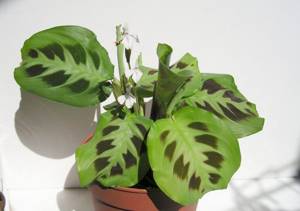
Kerkhoven's arrowroot is also known as "Bunny's Foot". It has large leaves of light green color with dark, sometimes brown spots on both sides of the central vein. The spots on the leaves are always clearly separated from each other and never merge into a single stripe. The height of the bush reaches 25 cm. The flowers are white or pale purple. It is an unpretentious variety.
Variety Tricolor or Fascinator

Tricolor is the most popular arrowroot variety grown at home. Sometimes in stores it can be found under the names “Fascinator” or “Red-veined”. The leaves of this variety are painted in 3 colors. The light green color smoothly flows into dark green from the edges to the center. Light green spots again run along the central vein. And all this is decorated with expressive crimson veins. The pattern is somewhat reminiscent of a fish spine. Blooms with light lilac flowers.
Marisella
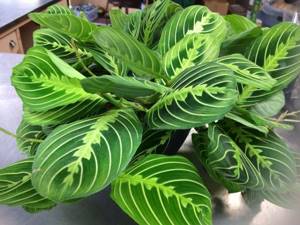
The background color of the leaves is rich green. The veins and stripes are light green. Arrowroot Maricella is similar to Arrowroot Tricolor and differs only in the color of the veins.
Beauty Kim
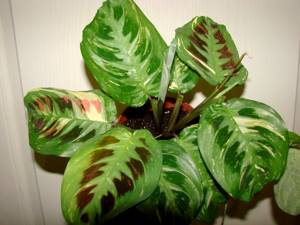
It has heart-shaped or oval large leaves. Beauty Kim is a variegated variety. The light green leaves have spots and streaks of light green, yellow, white and pink.
Emerald Beauty

Similar to the Massanja variety. The leaves are the same dark, becoming a little lighter towards the edges. There is a white spot along the central vein, which, in turn, is much larger than that of Massange.
Home care
The secret to successfully caring for arrowroot is maintaining the temperature and humidity conditions.
The ideal soil for constant growth is a mix of leaf, humus and coniferous soil mixed with sand and charcoal. But standard fibrous peat will not work. Also avoid the presence of lime. Provide high drainage at the bottom.
Temperature
The plant does not tolerate heat and heat above +28...+30C. Avoid direct sunlight, drafts, and sudden temperature changes. Optimal in winter – up to +20C. In winter, it is undesirable to lower it below +14C. At this time of year it is important to keep the leaves away from the cold window.
Fertilizer
During active growth, use complex fertilizers. Specialized solutions for decorative deciduous varieties are now sold. But don’t overuse it, because it’s equally important not to overfeed the arrowroot.
Watering
It is recommended to repeat abundant watering only as the top layer of the substrate dries. During cold weather, reduce the frequency to avoid rotting of the rhizome. For irrigation, use filtered water, or at least soft, settled water. Arrowroot is sensitive to any foreign impurities.
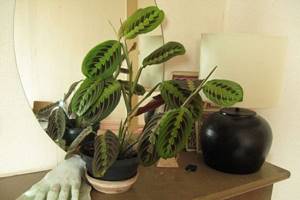
Humidity
Ideal air humidity is about 70%. It can be compensated for by systematically spraying the leaves. This is especially important in summer and during the heating season. A tray with water will help to increase the humidity locally, but in this case, make sure that the moisture does not get on the roots.
Arrowroot feels most comfortable in partial shade. In direct sunlight and bright lighting it fades. In the apartment, pay attention to the windows that face northwest or east.
Lighting
Lighting is one of the main aspects of proper care. The arrowroot plant does not like the sunny side. Sometimes a plant placed on the north side also suffers from too much light. This manifests itself in a change in the color of the leaves - they become pale and withered.
But by placing a flowerpot in the back of the room, you will notice that it will feel great. New leaves will grow faster, the color will be bright and rich, and flowering may even begin quickly. In winter, when daylight hours become shorter, the flowerpot can be placed closer to the window.
Direct sunlight negatively affects the condition of the plant. The leaves decrease in size and lose their color. A dark place of growth causes the leaf to fade. Ideal growing conditions are diffused light and artificial lighting with a fluorescent lamp (about 16 hours a day).

Transplantation and propagation
Arrowroot transplantation should include the following steps:
- You should remove the plant from the old pot, carefully remove any lumps of soil, prepare a new container, pour drainage first, and then add some of the prepared soil on top.
- Clean the flower from old and yellowed leaves. Wipe healthy leaves from dust and debris. If the bush is large, then it can be cut off at the root.
- Move the plant to a new pot, fill it well with the rest of the soil mixture and tamp it lightly. It is important to carefully examine the composition of the soil before replanting. If there is lime in the soil, then such soil cannot be purchased. Lime will negatively affect the development of the flower.
- Now you need to select fertilizer and top dressing for the arrowroot. Fertilizer must be added once every 14 days. In winter, you only need to add it once a month. Nutrient components must be added along with the liquid in a ratio of 1:1. If the plant is dormant, there is no need to fertilize it, and water it 3 times less often.
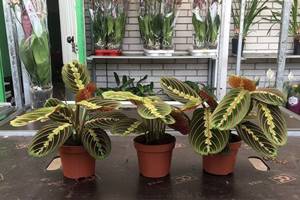
Arrowroot is propagated by three classical methods:
- 1. When sowing seeds, start growing seedlings immediately with the arrival of spring. Take a wide flowerpot or box, peat-sand substrate and seeds. The first shoots appear in the next 2 weeks. The main thing is to maintain a stable temperature, about +16°...+19°. As soon as several full leaves appear on the seedling, it can be replanted.
- 2. To root cuttings, cut shoots up to 10 cm from the mother plant with several full-fledged healthy leaves. The whole process takes about 4 weeks. Rooting can be done from May to September. As soon as the root is formed, transplant the arrowroot into a peat substrate.
- 3. Mature and healthy shrubs can be propagated by division. Dig up and clean the bush, then carefully cut the rhizome. It is important that each seedling has several healthy leaves and tubers. Before transplanting, treat the cuts with charcoal to disinfect. After this, they can be planted in moist, loose soil.
It is recommended to replant an adult plant annually, in early spring.
Reproduction methods
Breeding indoor arrowroot is possible in several ways.
Cuttings
At the end of spring, cut cuttings with 2-3 leaves from young shoots, the length should be about 8-10 cm. Place them in warm water. When the roots appear, you can transplant the cuttings into a container with an earthen mixture. To make the plant take root faster, it is recommended to cover it with film. It is removed regularly to ventilate and control soil moisture levels.
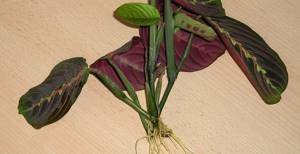
Dividing the bush
It is best to carry out the procedure during transplantation of arrowroot. Carefully remove the plant from the pot and divide into equal parts. Each cutting should contain enough tubers for further development. Plant the plants in separate pots with a suitable substrate. Cover the top with a bag to speed up rooting. After the young leaves appear, the bag can be removed.
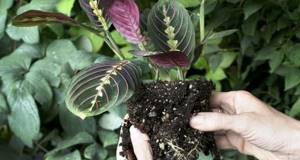
Pest and disease control
Arrowroot problems are typical for tropical plants. With a lack of moisture or heat, it weakens and withers, but with an excess of water, root rot appears and fungal diseases develop. This can be prevented by maintaining a stable regime and periodically treating the flower with antifungal drugs.
Leaves are sometimes affected by scale insects. They suck out the juice, which causes the plate to change color, damage and sticky drops appear on it. Parasites are removed mechanically using soapy water. After this, spray the leaves with a special preparation.
When the air is too dry, spider mites appear. You can get rid of them with a hot shower, but this must be done quickly and carefully. But in this way you can destroy parasites without chemicals, and this is especially important in an apartment. There are also special acaricides for pests.
Diseases and pests of arrowroot
The tips of the arrowroot leaves dry out. If air humidity is low, the tips of the leaves dry out and turn brown, and may even fall off. Plant growth slows down in dry air.
- Raspberry pests
Arrowroot is rotting. The stems lose turgor and may begin to rot if the air temperature is low in winter or watering is too abundant.
Spots on arrowroot leaves. If there is not enough moisture in the soil, spots appear on the leaves, they curl, and the lower leaves also turn yellow.
Maranta turns pale. Maranta does not like direct sun, because... under its rays the leaves lose their beautiful color and dry out.
Arrowroot pests. Most often, arrowroot is affected by spider mites.
Signs and superstitions about arrowroot
Superstitions and signs are associated with the flower:
- It is believed that it attracts material well-being and also strengthens the family hearth.
- According to legend, flowering is considered a good sign; with its beginning, the financial condition of its owners begins to improve.
- The placement of the plant in the bedroom makes the connection between spouses stronger and improves mutual understanding.
- Possessing positive energy, it has a beneficial effect on all family members. That is why many people strive to have this “prayer grass” in their home.
Reproduction
There are four methods of reproduction. Each method has its own advantages and disadvantages.
Seeds
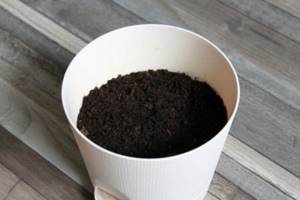
- fill the container with a mixture of sand and peat;
- lightly press the seeds into the soil - a depth of 1 cm is sufficient;
- cover the top with film;
- maintain a temperature of +25°C, periodically spray with water from a spray bottle;
- regularly remove condensation from the material and ventilate the room;
- After 2 weeks, remove the film.
The sprouts will be ready for transplantation in 2-3 months. Place young plants in separate pots, then follow the care instructions.
Leaf
Is an easy way to get a new stone rose. Advantages – guarantee of a good result, speed of the process. There are no disadvantages. Stages:
- separate the lower healthy leaf from the plant;
- dry the planting material well;
- Fill the pot with a mixture of soil and sand (2:1), sprinkle with perlite on top;
- moisten the soil well;
- at an angle, slightly pressing, insert the leaf 2-3 mm into the soil;
- cover the container with film, monitor the ambient temperature - it should be +25°C;
- Ventilate the room daily, moisten the soil as it dries.
After 3 weeks, rosette babies will form. Transplanting young plants into separate pots is possible after the parent leaf has dried. Subsequent maintenance is identical to caring for an adult flower.
Tops
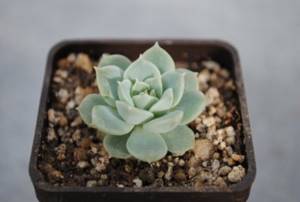
- cut off the top with a sharp knife, separate the lower leaves from this part;
- dry the planting material;
- place the top at an angle in the soil (2 parts earth and 1 part sand);
- cover with film;
- Ventilate and moisten as necessary.
Don't worry about the remaining stem from which the top was cut off. Over time, new shoots will form on it.
Rosettes
Popular method. Advantages: simplicity, early flower stalks. Disadvantages: long rooting time. Stages:
- separate a large and healthy rosette from the flower;
- sprinkle the cuts with coal or wood ash;
- dry the socket and place it in well-moistened sand;
- Maintain the ambient temperature within +24°C.
After final rooting, leave the seedling in the same container.

